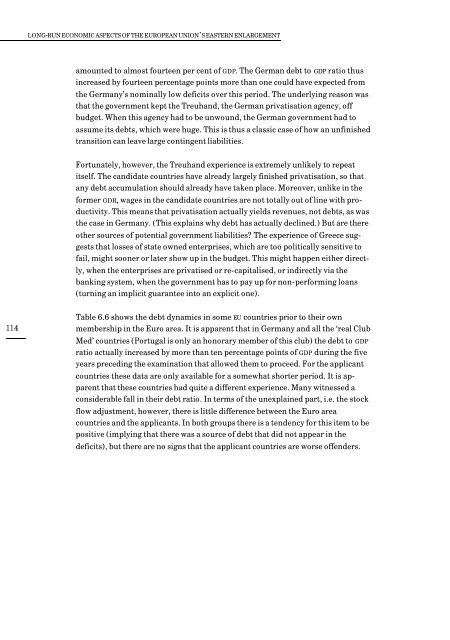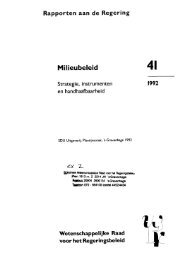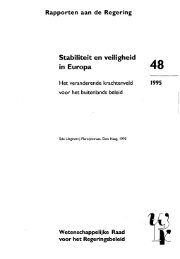w 109 long-run economic aspects of the european union's eastern ...
w 109 long-run economic aspects of the european union's eastern ...
w 109 long-run economic aspects of the european union's eastern ...
Create successful ePaper yourself
Turn your PDF publications into a flip-book with our unique Google optimized e-Paper software.
LONG-RUN ECONOMIC ASPECTS OF THE EUROPEAN UNION’S EASTERN ENLARGEMENTamounted to almost fourteen per cent <strong>of</strong> GDP. The German debt to GDP ratio thusincreased by fourteen percentage points more than one could have expected from<strong>the</strong> Germany’s nominally low deficits over this period. The underlying reason wasthat <strong>the</strong> government kept <strong>the</strong> Treuhand, <strong>the</strong> German privatisation agency, <strong>of</strong>fbudget. When this agency had to be unwound, <strong>the</strong> German government had toassume its debts, which were huge. This is thus a classic case <strong>of</strong> how an unfinishedtransition can leave large contingent liabilities.Fortunately, however, <strong>the</strong> Treuhand experience is extremely unlikely to repeatitself. The candidate countries have already largely finished privatisation, so thatany debt accumulation should already have taken place. Moreover, unlike in <strong>the</strong>former GDR, wages in <strong>the</strong> candidate countries are not totally out <strong>of</strong> line with productivity.This means that privatisation actually yields revenues, not debts, as was<strong>the</strong> case in Germany. (This explains why debt has actually declined.) But are <strong>the</strong>reo<strong>the</strong>r sources <strong>of</strong> potential government liabilities? The experience <strong>of</strong> Greece suggeststhat losses <strong>of</strong> state owned enterprises, which are too politically sensitive t<strong>of</strong>ail, might sooner or later show up in <strong>the</strong> budget. This might happen ei<strong>the</strong>r directly,when <strong>the</strong> enterprises are privatised or re-capitalised, or indirectly via <strong>the</strong>banking system, when <strong>the</strong> government has to pay up for non-performing loans(turning an implicit guarantee into an explicit one).114Table 6.6 shows <strong>the</strong> debt dynamics in some EU countries prior to <strong>the</strong>ir ownmembership in <strong>the</strong> Euro area. It is apparent that in Germany and all <strong>the</strong> ‘real ClubMed’ countries (Portugal is only an honorary member <strong>of</strong> this club) <strong>the</strong> debt to GDPratio actually increased by more than ten percentage points <strong>of</strong> GDP during <strong>the</strong> fiveyears preceding <strong>the</strong> examination that allowed <strong>the</strong>m to proceed. For <strong>the</strong> applicantcountries <strong>the</strong>se data are only available for a somewhat shorter period. It is apparentthat <strong>the</strong>se countries had quite a different experience. Many witnessed aconsiderable fall in <strong>the</strong>ir debt ratio. In terms <strong>of</strong> <strong>the</strong> unexplained part, i.e. <strong>the</strong> stockflow adjustment, however, <strong>the</strong>re is little difference between <strong>the</strong> Euro areacountries and <strong>the</strong> applicants. In both groups <strong>the</strong>re is a tendency for this item to bepositive (implying that <strong>the</strong>re was a source <strong>of</strong> debt that did not appear in <strong>the</strong>deficits), but <strong>the</strong>re are no signs that <strong>the</strong> applicant countries are worse <strong>of</strong>fenders.

















